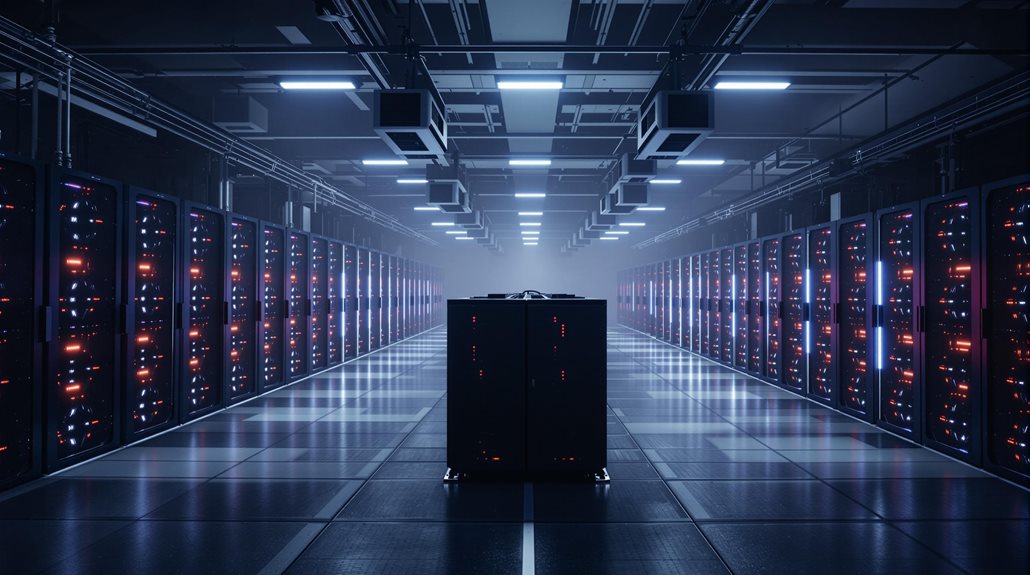A cryptocurrency farm is a large facility filled with powerful computers that mine digital currencies like Bitcoin. These specialized machines work around the clock, solving complex math problems to earn crypto rewards. The facilities need extensive cooling systems to prevent equipment from overheating and require massive amounts of electricity to operate. Farms often join mining pools to combine their computing power and increase their chances of success. Understanding how these farms work reveals fascinating insights into modern digital mining operations.

A cryptocurrency farm is a large facility where powerful computers work around the clock to mine digital currencies like Bitcoin. These facilities are often set up in large warehouses equipped with special cooling systems to keep the mining equipment from overheating. Sophisticated mining management software helps monitor and optimize the entire operation. They're basically like data centers, but instead of storing information, they're solving complex math problems to earn cryptocurrency rewards.
The main equipment used in crypto farms includes specialized computers called ASIC miners and GPU miners. ASIC miners are built for mining specific cryptocurrencies, while GPU miners are more flexible and can mine different types of digital currencies. These machines need massive amounts of power to run, so crypto farms have robust electrical systems and careful energy management. Currently, the United States dominates the global mining landscape with 37.8% of all mining activities.
To be successful, crypto farms usually join mining pools, where they combine their computing power with other miners to increase their chances of earning rewards. It's like a team effort – everyone contributes their computing power and shares the rewards when they successfully mine new cryptocurrency. Using the SHA-256 algorithm, miners repeatedly hash block information until they find a valid solution. The farms employ technical experts who keep an eye on the equipment 24/7, making sure everything's running smoothly and fixing any problems that come up.
Starting a crypto farm isn't cheap. It requires a lot of money upfront to buy the equipment and set up the facility. The ongoing costs are significant too, especially the electricity bills, which can be enormous. That's why many crypto farms are backed by big investors or are part of publicly traded companies. They need deep pockets to cover these expenses and keep the operation running.
The profitability of a crypto farm depends on several factors. The price of cryptocurrencies is a big one – when prices go up, mining becomes more profitable. But there's also something called mining difficulty, which changes over time. As more people start mining, it gets harder to earn rewards, and farms need to upgrade their equipment to stay competitive.
These operations benefit from economies of scale, meaning they can mine more efficiently than smaller operations. They have better buying power for equipment, can negotiate better electricity rates, and spread their costs across a larger operation.
However, they also face challenges like changing cryptocurrency regulations, market volatility, and the need to constantly upgrade their technology to stay competitive in this fast-moving industry.
Frequently Asked Questions
How Much Electricity Does a Typical Cryptocurrency Mining Farm Consume Monthly?
A typical crypto mining farm's electricity use varies quite a bit.
Small to medium farms consume between 100 kilowatts to 1 megawatt monthly, while large operations can use anywhere from 1 to 100+ megawatts.
The exact amount depends on several factors: the number of mining machines, their efficiency, cooling needs, and how long they run.
Most farms operate 24/7 to maximize profits, which adds up to significant power usage.
What's the Average Lifespan of Mining Hardware in a Crypto Farm?
Mining hardware typically lasts 3-5 years in a crypto farm.
However, this can vary based on how it's used and maintained. Some miners might only last 2 years, while others can run for up to 10 years under perfect conditions.
The environment plays a big role – things like temperature, dust, and humidity affect how long the machines last.
Most major manufacturers, like Bitmain, say their hardware should work for at least 5 years.
Do Cryptocurrency Farms Affect Local Property Values in Surrounding Areas?
Cryptocurrency farms can definitely impact local property values, but it's not a simple yes or no effect.
They often lower residential property values due to noise from mining equipment and increased power usage in the area.
However, they might raise some commercial property values by attracting tech businesses.
The impact largely depends on the farm's size, location, and how well it's managed.
Community opinions and local regulations also play a big role.
Can Residential Zones Legally Host Small-Scale Cryptocurrency Farming Operations?
Small-scale crypto farming in residential zones depends on local laws.
While some areas allow it with home occupation permits, others strictly prohibit it. The main concerns are noise from mining equipment, high power usage, and potential disruption to neighbors.
Local zoning codes often classify crypto mining as industrial or data center activity. Some cities and towns are creating specific rules just for cryptocurrency mining in residential areas.
What Noise Levels Do Cryptocurrency Farms Typically Generate?
Cryptocurrency farms create significant noise levels from their mining machines. A single mining machine typically produces 70-90 decibels, which is about as loud as a vacuum cleaner.
When multiple machines run together, the noise gets even louder – 10 machines reach around 85 decibels, while 100 machines can hit 95 decibels.
This noise level is similar to what you'd hear in a nightclub, which averages around 98 decibels.





